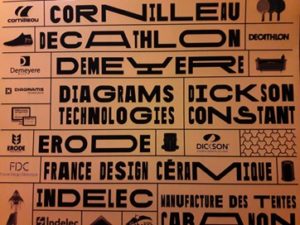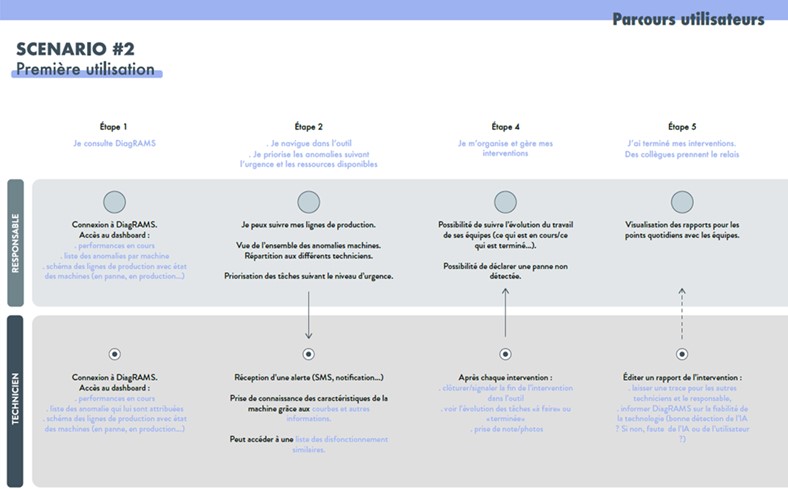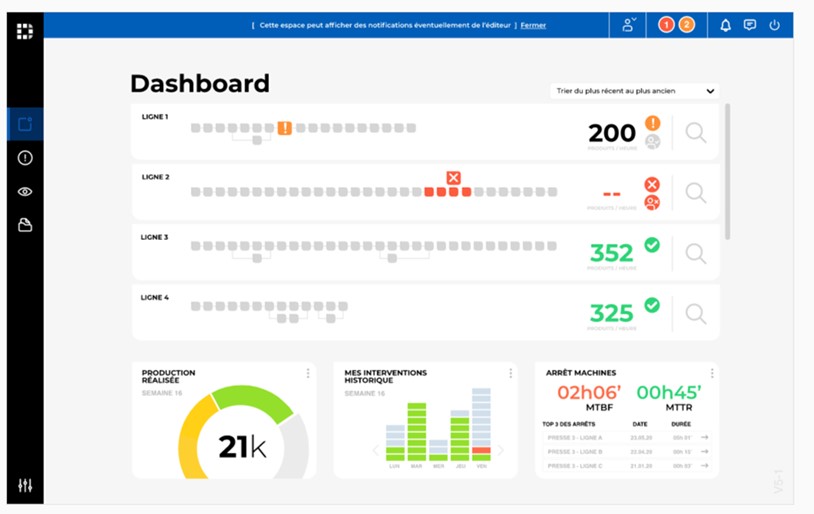Innovation centred on the uses of DiagRAMS software
30 November 2021If DiagRAMS Technologies has been selected as one of the best examples of design for business innovation, it is not by chance. Its software solution was designed according to a UX design approach to meet efficiency and user satisfaction.
Adeo, Decathlon, Dickson… and DiagRAMS Technologies are featured in the “Dépliages” exhibition, co-produced by the Cité du design de Saint-Étienne and Lille Design as part of France Design Week, and hosted by the Hauts-de-France region. What do they have in common? Design, how it intervenes in the company’s ecosystem, how it fits into the innovation strategy between observation of uses, understanding of the industrial process and the design approach. This is one of the strengths of DiagRAMS Technologies and its originality on the market: having used a UX design approach to design its predictive maintenance solution with innovation centred on real uses and adaptability to different industrial contexts.
UX DESIGN ?
Behind the somewhat barbaric word UX design, for User eXperience Design, lies an approach whose benefits are increasingly recognised for optimum efficiency of the product or service concerned.
“If the process is now widespread in the B2C sector, which has understood that the challenge of acquiring a service lies in the quality of the user experience, the B2B sector is gradually moving beyond a simple vision of feasibility and functionality to take a real interest in usage,” explains Mathilde Adriaenssens, in charge of transformation and service design at the Keyuz agency.
The stakes: trust, interactions, functionalities, handling… in short, efficiency and user satisfaction.
CREATE AN OPTIMAL USER EXPERIENCE
With its predictive maintenance solution, DiagRAMS Technologies helps manufacturers in their fight against breakdowns and malfunctions of all kinds that can have dramatic consequences. However, maintenance technicians need to have an optimum user experience and be able to use it easily. This is why the start-up has implemented a UX design approach with the Keyuz agency to design the software layer of its solution.
“We started from an almost blank page with just the visions and studies of the DiagRAMS managers. We didn’t want to create a gas factory, but rather a product with the right features and the best way to use them, especially with the Machine Learning technology from Inria, which offers power and accessibility to users,” emphasises Mathilde Adriaenssens.
ANALYSIS AND SPECIFICATIONS
How does it work in practice? First of all, there is an essential stage of analysis of uses, constraints, the context, the technicians… everything that include the service provided to users. To do this, interviews were conducted with technicians and maintenance managers, and then “quasi-ethnological” observation sessions were organised on different sites and in different industrial sectors in order to draw up the most precise specifications possible and stimulate creativity. Then came the phase of designing wireframes, or functional models, during a collaborative workshop to define the user path, then wireflows to draw the content proposed by the tool and all the possible interactions.

UI DESIGN
In addition to UX design, UI design, for User Interface, is also involved, i.e. the graphic environment in which the software user evolves. This mission was entrusted to Pierre Jankowiak, Senior Lead UX, who had to deal with a plural industrial environment and disparate conditions of use:
“The interest is not to aim for the wow effect but for ease of handling and use to reduce the learning curve, and then to work on effectiveness, i.e. to minimise clicks, and efficiency, i.e. to reduce the time needed to process the task.”
The whole process is based on behavioural sciences, as well as creative methods.
“The idea is to reduce the user’s cognitive load, to help them process information and make decisions with access to the right indicators at the right times and easy interactions to remedy them.”

A CONTINUOUS INNOVATION PROCESS
All these steps allowed Nicolas Froidure, Technical Lead for DiagRAMS Technologies, to put all this in technical consistency in terms of development:
“We were able to put all our energy into the really useful elements, because simplicity is ultimately the most complex thing to achieve!”
Another advantage, and not the least, is that all this work also makes it possible to anticipate the necessary technical developments, both in terms of code and functionality.
“This type of solution necessarily follows a process of continuous innovation, especially as it also accompanies the digital and managerial transformation of clients” concludes Mathilde Adriaenssens.
Continuous innovation is also developed by listening to customers in order to provide the necessary new features and to develop the software accordingly.


